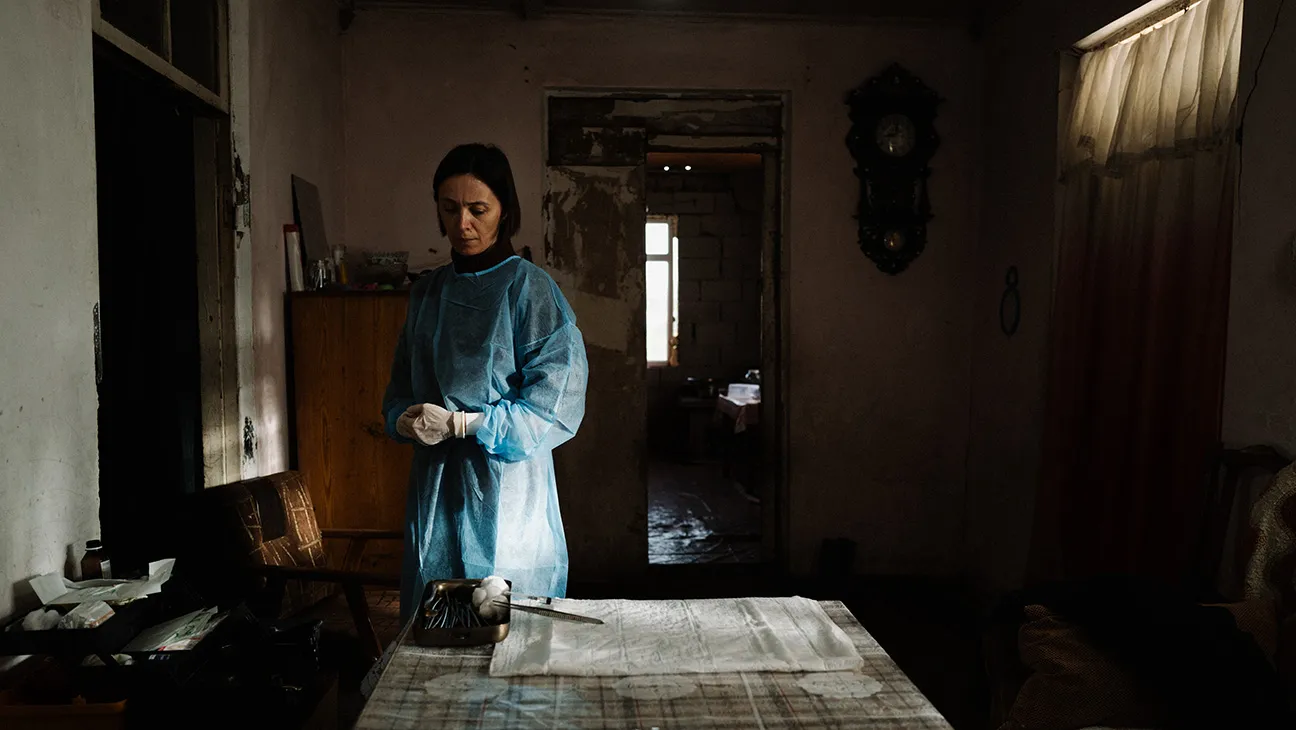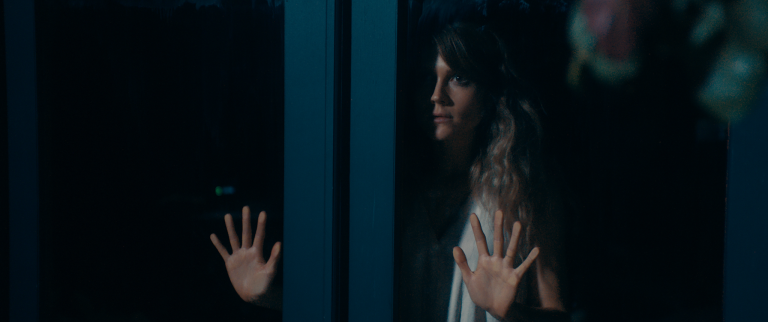Dea Kulumbegashvili’s powerful sophomore feature “April” opens up to a creature in a void, lit dimly enough for the viewer to observe its disfigured body. Offscreen, the sound of trickling water is mixed with children playing and cheering. The camera retains its position, unwaveringly static, observing the monstrosity achingly stagger in what sounds like puddles of water. It’s too dark to know what’s happening (or not), so the dread picks up as Kulumbegashvili lets the shot linger in the monster’s oblivion.
The creature (an alien? or a humanoid?) breathes painfully; perhaps it’s not an enemy, and it’s weak and scared and what escapes its mouth are pleas for help. It continues to stagger, achingly moving its limbs in unpredictably slow motions. Phlegmy breathing echoes in the dark, and so do children laughing and playing. Years of cheap horror movies have conditioned the average moviegoer for a gnarly jumpscare, it’s what the scene must be leading to. The shot lingers, and the anxiety peaks, only to cut to a puddle collecting rain. And the scene after it is real footage of a woman in the throes of delivering a newborn.
“April” is replete with scenes whose horror, such as the opening frame, bombards your senses with incomprehensible doubt more than fear — each shot is foreboding, unsettling, some surreal and not, all constructed realities whose connection between plot, more than character, are disparate and hard to judge. One moment we see a field of poppies in a storm, the next a monster in a room.
Add to the fact you’re on high alert, courtesy of its excellent audio-visual trickery, and forced to put the pieces of a seemingly straightforward story among a watery narrative. All this makes “April” both frustrating and rewarding to watch — it demands everything and nothing from the viewer, with each frame more perplexing than the next. But in the end, Kulumbegashvili’s frames stir a profoundly intellectual whiplash that subtly racks your brain long after the credits spell.
Perhaps the intended effect is to reach the brain stem and not just the retina; of driving home the point in an unforgettable fashion of the unimaginable horrors women face when their autonomy, of body and mind, is systematically oppressed not just in the public sphere, but even silently in the private eye; that when a woman feels she has a vestige of liberty, it’s a farce.

Nina, our protagonist, lives in a grim reality where a woman’s agency, her identity, and even her needs and wants are controlled, exploited, and kept shackled under the institutional power of the patriarchy. Abortion is legal in Georgia however the religious condemnation it receives from ultra-conservative villages effectively makes it a non-right, which is where the events of “April” unfold.
Moonlighting as an illegal abortionist and dispensing under-the-counter contraceptive pills to minor wives, Nina’s cover is blown when she faces allegations of mishandling a delivery. It’s a stark scene – Nina faces the anger of the young father, loud and raging, and with it, quietly, the silent grief of the young mother. An investigation ensues, threatening Nina’s career and her place as a guardian of the village’s women
Kulumbegashvili’s screenplay skirts integral plot points but retains nuance – conflict and action are one of the same, and the information presented on screen often eludes narrative attachment. At one point, three stories run parallel (the monster is very much there), crisscrossing one another to create tension and mystery, throttling the narrative forward. Clocking in at more than two hours, Kulumbegashvili excels in plotting the narrative to entrance the viewer– the surrealism and the absurdness of the world, coupled with its bloodless brutality, invite the viewer to look harder, deeper into its challenging frames.
The sparse, interpretive script is felt more when we learn of Nina’s own personhood, of her sadomasochism like in the tight-lipped manner of Erika Kolhut in “The Piano Teacher,” of her past with a fellow colleague David although her resigned, exhausted face indicates a secret but traumatic baggage. Nina leverages her modern social capital to bring change but she still falls victim to the patriarchy’s bureaucracy. Her progressiveness restrains her ability, there’s no way forward without facing vilification and vitriol from everyone. Yet she braves them.
Kulumbegashvili’s direction is a tightly-strained yet also liberatingly human. Brutality and uncompromising honesty are encoded in Kulumbegashvili’s cinematic DNA, and so is a potent strain of empathy love, and hope for her characters, even though the situation evades any situation for joy. Moments when Nina’s face lights up are treasured, mostly because there’s nothing to crack a smile over in this horror.
Shades of Bela Tarr, Cristian Mungiu, and Terrence Malick tint Kulumbegashvili’s vision – the futilities of humanity and its disgracefulness are captured objectively, balancing grandness and detail. DP Arseni Khachaturan prefers long, static takes, eking out tension effectively as well as letting it all loose, the camera sometimes having a mind of its own to capture a thunderstorm brewing in the periphery of the landscape. Kulumbegashvili’s style achieves a balance of rigor and liberty to capture the subjective horrors of Nina’s obstacles.
“April” is, without a doubt, haunting, deeply sensory but also oddly human in what it wants to uncover. It’s no easy task to examine the intricate, inextricable intersections of womanhood with modernity, religion, trauma, sex, and the looming shadow of the patriarchy. Yet Dea Kulumbegashvili’s approach of combining the surreal with the real, the bizarre with the straightforward, presenting the unseeable frictions of our challenged realities, exposes the truth in a provocative but deeply effective manner.




![Kubo and the Two Strings [2016]: Of Memories and Magic](https://79468c92.delivery.rocketcdn.me/wp-content/uploads/2016/11/kubo-main_0.jpg)

![Raees [2017] : A two hour long SRK Swag-fest, in a Good Way.](https://79468c92.delivery.rocketcdn.me/wp-content/uploads/2017/01/raees-1-768x483.jpg)
![Brotherhood [2021] ‘Locarno’ Review – An Impressive Coming of Age Documentary](https://79468c92.delivery.rocketcdn.me/wp-content/uploads/2021/08/Brotherhood-2021-768x431.jpg)
